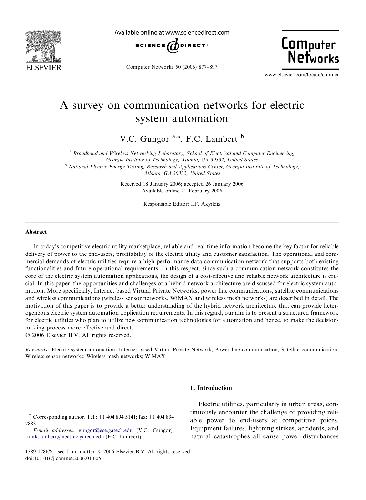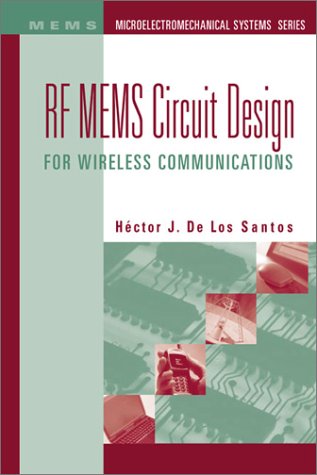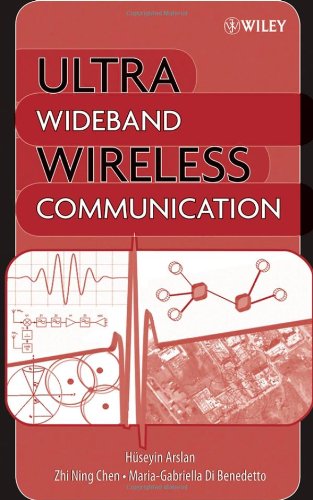Gungor V.C., Lambert F.C.
Table of contents :
Introduction……Page 1
Internet based Virtual Private Networks……Page 4
Last mile connectivity for electric utilities……Page 5
Disadvantages……Page 7
Optical fiber communication……Page 8
Wireless communication……Page 9
Wireless sensor networks for automation……Page 10
Benefits of wireless sensor networks for automation……Page 11
Wireless automatic meter reading (WAMR)……Page 12
Electric system monitoring……Page 13
Application requirements……Page 14
WiMAX and wireless mesh networks for automation……Page 15
Benefits of hybrid network architecture using WiMAX and wireless mesh networks……Page 16
Design challenges of hybrid architecture using WiMAX and wireless mesh networks……Page 17
Conclusion……Page 18
Acknowledgements……Page 19
References……Page 20
Introduction……Page 22
Related works……Page 24
The AIPAC implementation……Page 25
Initial address configuration……Page 26
Management of IP address duplication……Page 28
Management of partitioning……Page 29
Gradual merging……Page 32
Reference scenario……Page 34
Variations of the traffic according to igm……Page 36
Traffic generated per type of packet……Page 37
Traffic with a reduced set of IP addresses……Page 40
Changes in reference scenario……Page 41
Conclusion and future works……Page 42
References……Page 43
Introduction……Page 45
Related work……Page 46
The proposed scheme……Page 47
End-to-end rate control model……Page 48
Adaptive transmission rate for a single client……Page 49
Congestion controlled adaptive transmission rates……Page 51
Optimal bandwidth allocation……Page 52
Adaptive transmission rate control……Page 53
Concurrent client presentation support……Page 55
TCP-friendly congestion control……Page 57
References……Page 60
Introduction……Page 62
Related work……Page 63
Spatial query patterns by using quadtree……Page 64
Data querying by task sets……Page 66
Performance evaluations……Page 68
Event detection rate……Page 69
Experimental results……Page 71
Conclusions……Page 74
References……Page 75
Introduction……Page 77
Statement of the problem……Page 79
Transformation of the problem……Page 82
Transformation of the problem……Page 83
Dynamic programming method……Page 84
Experimental results……Page 85
Conclusion……Page 87
References……Page 88
Dynamic online QoS routing schemes: Performance and bounds……Page 90
Introduction……Page 91
Widest shortest path algorithm……Page 92
Virtual flow deviation……Page 93
The virtual calls……Page 94
Complexity comparison……Page 95
Mathematical models……Page 96
Ideal routing model……Page 97
Min-cut model……Page 99
Numerical results……Page 100
References……Page 103
Pricing differentiated services: A game-theoretic approach……Page 106
Introduction……Page 107
The model……Page 108
Computing the throughputs……Page 109
Utility, pricing and equilibrium……Page 110
Equilibrium for only real-time sessions or only TCP connections……Page 111
Supermodular games……Page 112
Algorithm for symmetric Nash equilibrium……Page 115
Symmetric real-time flows……Page 116
Nonsymmetric real-time flows……Page 118
Symmetric TCP connections……Page 119
Conclusions and future work……Page 120
Proof of Theorem 2……Page 123
Proof of Theorem 4……Page 124
References……Page 125
Introduction……Page 127
Features of soft handoff……Page 128
The novel channel reservation scheme mdash the capacity acquisition protocol……Page 131
The analytical model……Page 133
Derivations of C1 and C2……Page 134
Derivations of lambda h……Page 135
System parameters of analytical model……Page 137
Comparison with simulations……Page 138
Comparisons with the scheme withoutchannel reservation……Page 139
Comparisons with the adaptive reservation scheme……Page 141
A load-adaptive capacity acquisition protocol and its performance……Page 142
Practicality of the capacity acquisition protocol……Page 144
References……Page 145
9.pdf……Page 146







Reviews
There are no reviews yet.